Small business owners and solopreneurs wear many hats. From managing finances to handling customer service, your plate is always full. Adding social media marketing to the mix may seem overwhelming and time-consuming. But the right strategy and tools can be a game-changer for your business.
In today’s digital-focused market, having a strong presence on social media is crucial for any business looking to thrive. It allows you to connect with potential customers, build brand awareness, and drive sales, all at a fraction of the cost of traditional marketing methods.
Plus, it’s proven to be successful. According to an article from Forbes, “76% of social media users have purchased something they saw on social media,” and “the average CTR of ads across social media was 1.21% in 2022.”
But we understand that, as a busy entrepreneur, you may not have the time, money, or expertise to invest in complicated social media marketing strategies. That’s where Semrush Social comes in. Our easy-to-use platform is designed to simplify social media management for small business owners and solopreneurs.
In this article, we’ll share tips on creating a winning social media marketing strategy, as advertised. We’ll also talk about how your friends at Semrush can help you create one that aligns with your limited technical knowledge and makes your life easier.
Before we get into the specifics, let’s first understand what a social media marketing strategy is. Simply put, it is a plan that outlines your goals and tactics for using social media to promote your business and engage with your target audience.
Having a solid social media marketing strategy in place can help you save time, money, and effort by allowing you to focus on the most effective tactics for your business. It also helps ensure consistency in your messaging across different platforms.
Creating a social media marketing strategy may seem daunting, but with Semrush’s easy-to-use platform and our 9-step guide, you’ll be on your way to success in no time. So grab your pencil and get ready to learn!
Step 1. Choose Goals That Align to Business Objectives
The first step in creating an effective social media marketing strategy is to define your goals. These should align with your overall business objectives. Are you looking to increase brand awareness, drive website traffic, or generate leads? Identifying your goals helps you measure the success of your efforts.
Look at your business plan and determine what you want to achieve through social media. Once you have a clear understanding of your goals, Semrush’s tools can help you track them and provide valuable insights.
Step 2. Learn Everything You Can About Your Audience
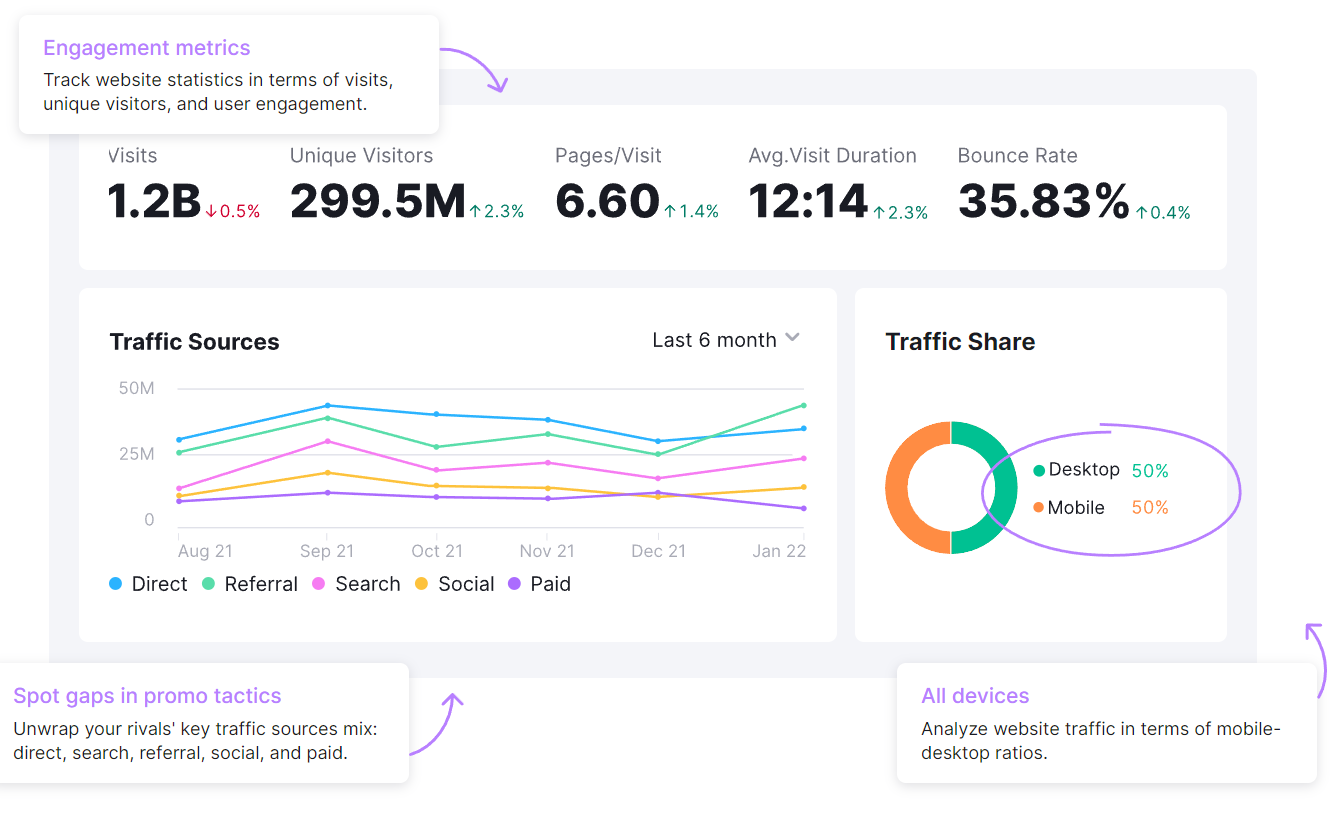
Understanding your target audience is crucial for any marketing strategy. Think about what you need to focus on in particular. Is it their age, location, or interests?
This information helps you create targeted and engaging content that resonates with your audience. You can also use Semrush’s Audience Insights report to gain valuable insights into your audience’s demographics, interests, and online behavior.
Step 3. Get To Know Your Competition
It’s always a good idea to keep an eye on your competition. Use Semrush’s Website Competitor Analysis Tools to analyze their social media presence, content, and engagement levels.
This gives you ideas for your content and helps you identify any gaps or opportunities in the market that you can capitalize on. It also gives you an idea of what works and what doesn’t in your industry.
Step 4. Do a Social Media Audit
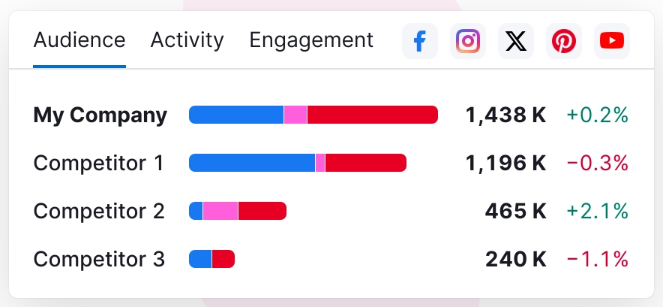
If you already have social media accounts set up, it’s essential to do a thorough audit using Semrush Social. This helps you identify which platforms are working for your business and which ones may need more attention.
It also gives you insights into audience demographics, engagement levels, and top-performing posts. Use this information to refine your strategy and focus on the platforms that are most beneficial for your business.
Step 5. Set Up Accounts And Improve Profiles
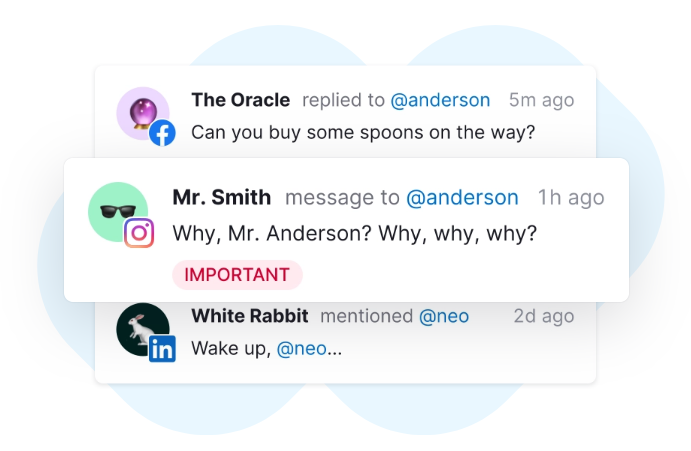
If you’re new to social media, Semrush makes it easy to set up accounts on all the major platforms, including Facebook, Instagram, Twitter, and LinkedIn. And if you already have accounts but haven’t optimized your profiles, Semrush Social can help with that, too.
Optimizing your profile includes having a clear and engaging bio, using high-quality visuals that represent your brand, and ensuring all necessary information such as website links are included. This makes it easier for potential customers to find and connect with you.
Step 6. Find Inspiration
Sometimes, coming up with content ideas can be a challenge. But the AI-powered Social Content Ideation tool can help you find inspiration by generating strong content ideas across a variety of topics and helps create that content for specific social media networks.
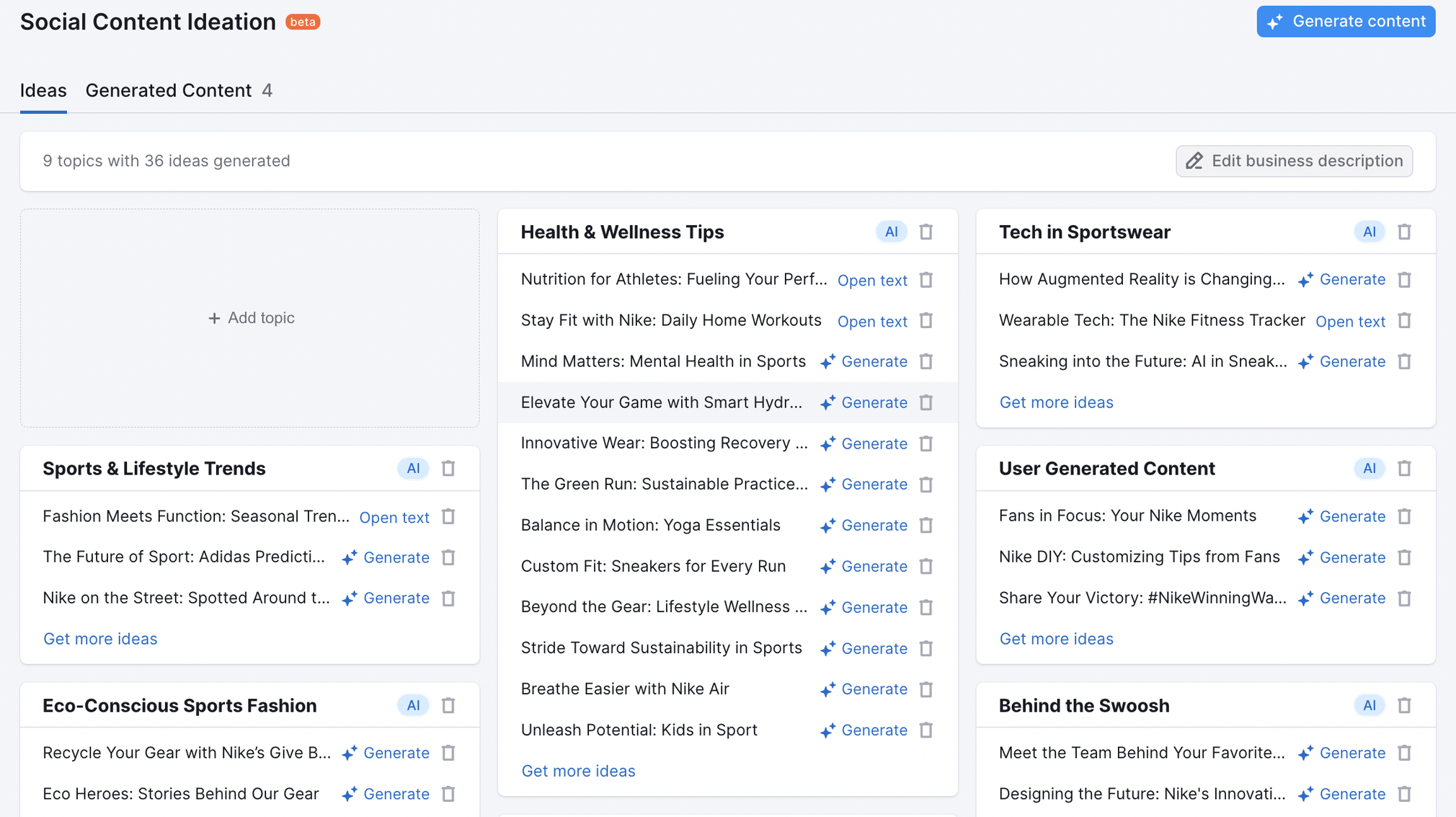
Some other great places to find inspiration are industry publications, trending hashtags, and your customers’ questions or feedback. These options ensure your content stays relevant and engaging for your audience.
Step 7. Create a Social Media Content Calendar
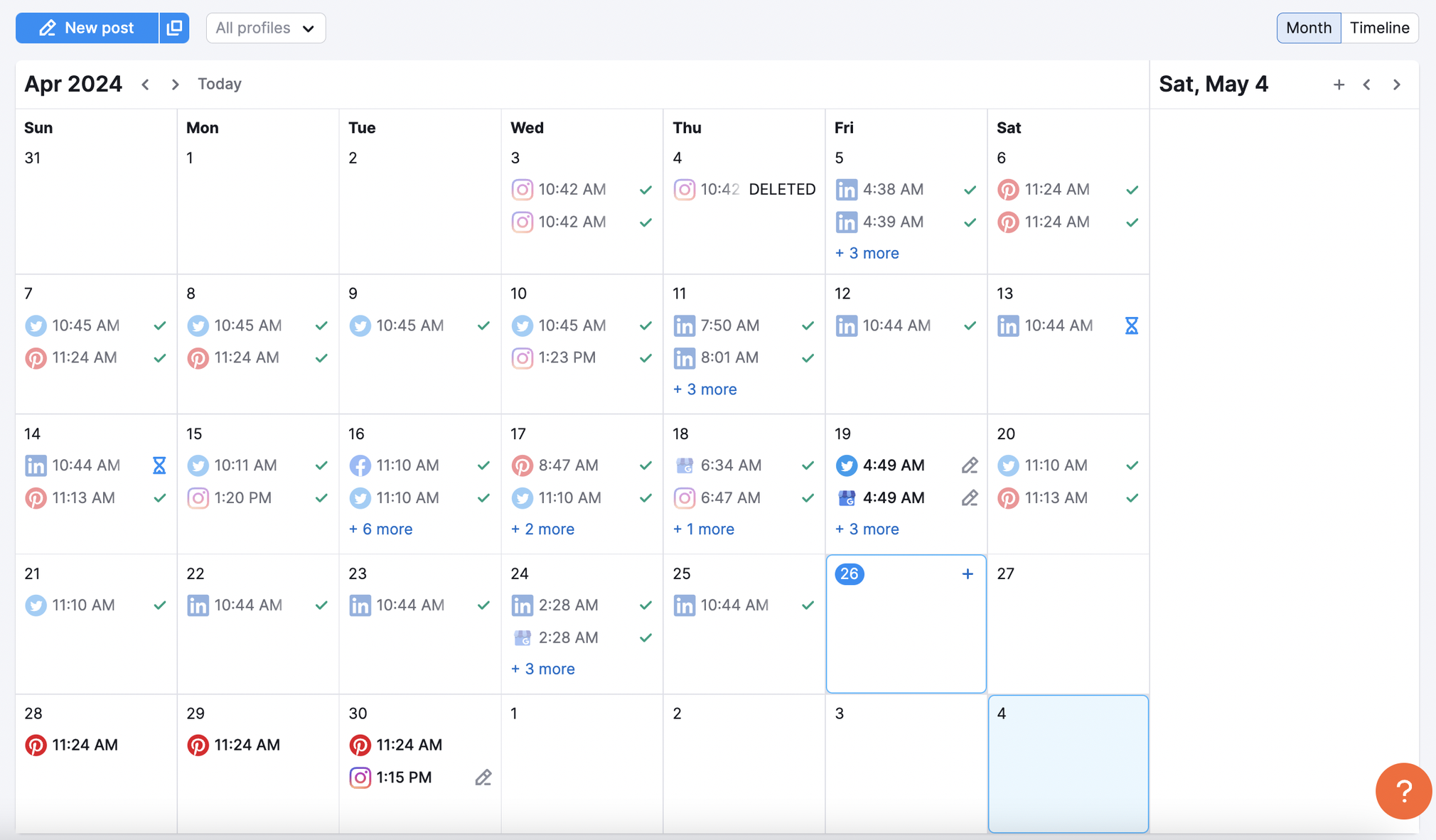
Consistency is key when it comes to social media marketing. We recommend creating a content calendar using Semrush’s Social Poster. This feature allows you to schedule posts in advance, so you don’t have to worry about posting every day manually.
Your content calendar should include a mix of promotional and informative posts, as well as engagement tactics like polls or user-generated content. Make sure to plan for holidays and special events relevant to your business.
Step 8. Create Compelling Content
With the rise of social media, consumers are bombarded with content from all directions. To stand out from the crowd, your content needs to be compelling and engaging.
If you want to save time while consistently growing your social networks with posts that match your brand’s look and feel, try using the Social Content AI suite:
- Brainstorm with AI: Just add your URL, and receive back a plan with +100 social post ideas/day, categorized by topics.
- Generate copy: The AI crafts posts for you based on your URL and chosen topic in seconds.
- Stand out visually: Instantly craft unique images for your posts that match your brand’s look and feel with AI.
- Reshape: Not quite right? Edit and refine any content piece, whether generated by you or AI. Your vision, perfectly realized.
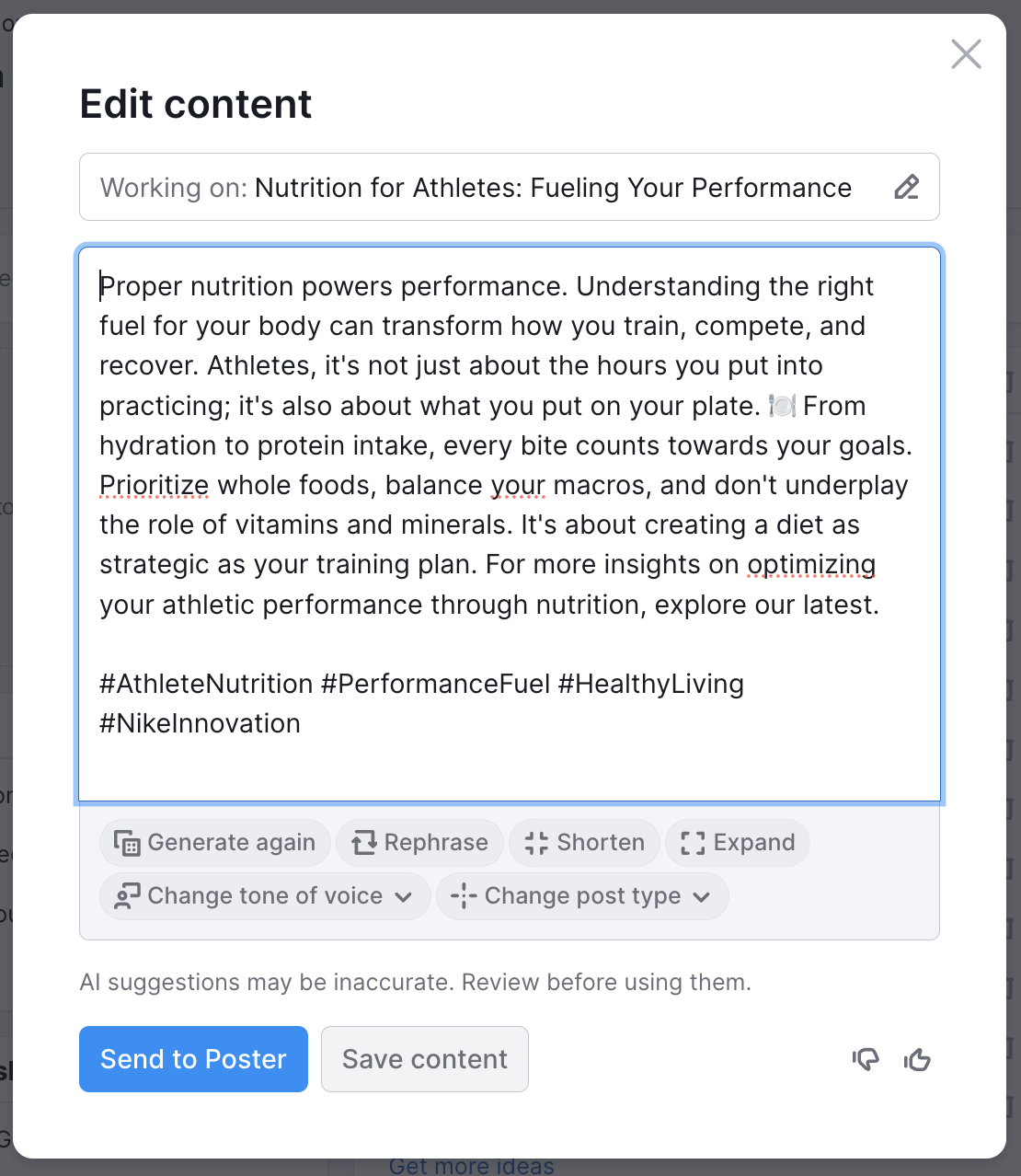
Don’t be afraid to get creative with your content! Experiment with different types of posts such as videos, infographics, or user-generated content to see what resonates best with your audience.
Step 9. Track Performance And Make Adjustments
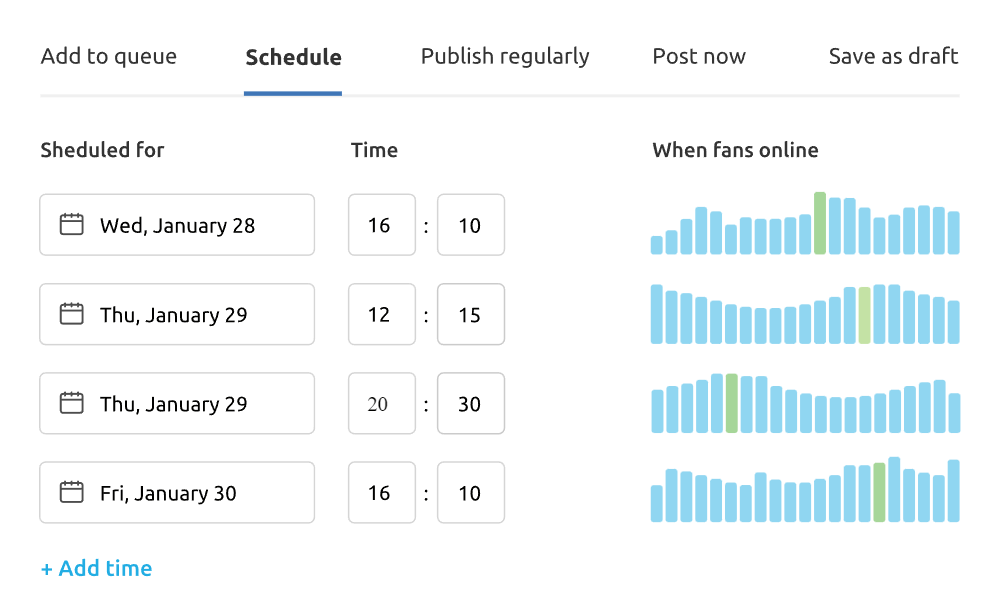
The beauty of social media marketing is that it allows you to track your performance and make adjustments in real time. Semrush’s Social Poster offers analytics and reporting features that help you understand how your posts are performing.
Keep an eye on metrics such as engagement, reach, and click-through rates. These insights help you understand what’s working and what needs improvement in your strategy.
If a particular post or campaign isn’t getting the desired results, don’t be afraid to make changes. Try out different types of content, posting times, or target audience demographics until you find the winning formula for your business.
To help you get started, we’ve created a free social media marketing strategy template you can download and use with Semrush. It includes all the essential elements of a successful strategy, such as:
- Goals: Identify what you want to achieve through your social media efforts. This could be increasing brand awareness, driving website traffic, or generating leads.
- Target Audience: Define who your ideal customer is and where they spend their time on social media.
- Platforms: Choose which social media platforms are best suited for reaching your target audience.
- Content Strategy: Determine the type of content (e.g., images, videos, blog posts) that resonates with your audience and aligns with your brand.
- Content Calendar: Plan when and how often you post on each social media platform.
- Engagement Strategy: Decide how you want to interact with your followers, respond to comments and messages, and build relationships through social media.
- Analytics: Set up tracking tools to measure the success of your strategy and make adjustments as needed.
- Tools: Choose the right tools to help you execute your strategy efficiently.
- Bonus Tip – Remember to think about creativity and experimentation! Social media is about trying new things and seeing what works best for your business.
You can use this template as a guide and customize it to fit your specific business needs. The best part? It’s completely free! Try it here.
FAQs
What Are Some Social Media Marketing Strategies?
There are various social media marketing strategies, but some popular ones include:
- Creating engaging content that resonates with your target audience
- Utilizing hashtags to reach a wider audience and increase visibility
- Collaborating with influencers or other brands to expand your reach
- Running paid advertisements on social media platforms
- Engaging with your audience through comments, messages, and shares
- Hosting contests or giveaways to increase engagement and brand awareness
- Using social media analytics to track your progress and make data-driven decisions
While all of these strategies can be effective, it’s important to choose the ones that align with your business goals and target audience.
What Is An Example Of A Social Marketing Strategy?
Let’s say you run a small bakery and want to increase your online presence and drive more sales through social media. One of many social media marketing strategy examples could include the following steps:
- Define Your Goals: Looking to increase website traffic, boost sales, or improve brand awareness? Clearly define what success looks like for you. Some of these goals are interconnected, too.
- Know Your Audience: Identify who your target customers are and which social media platforms they use the most. Maybe you get a lot of FaceBook moms who need last-minute bake sale items, or your typical customer is a teenager who loves posting your Instagrammable desserts.
- Choose The Right Channels: Based on your target audience, choose 2-3 social media platforms where to focus your efforts.
- Create Compelling Content: Share mouth-watering photos of your baked goods, behind-the-scenes footage of your bakery, and customer reviews to engage and attract potential customers.
- Engage With Your Audience: Respond to comments, messages, and mentions on time to build relationships with your followers.
- Utilize Social Media Advertising: Consider investing in paid ads on social media platforms to reach a larger audience and drive more sales.
- Track And Analyze Results: Use the Traffic Analytics tools to track the performance of your social media efforts and make adjustments as needed.
How Do You Create A Social Media Marketing Strategy?
Creating a social media marketing strategy may sound daunting, but it doesn’t have to be. With Semrush, you can follow their simple Social Media Strategy Template, which is easy to customize to your situation. Or you can follow our helpful advice in the article above!
How To Create A Social Media Strategy For Small Businesses?
Creating a social media marketing strategy for small business use doesn’t have to be difficult. Your friends at Semrush have simplified the process into just five easy steps (or you can look above for more detailed information!):
- Define Your Goals: Start by identifying what you want to achieve through social media marketing. Is it to increase brand awareness? Drive website traffic? Generate leads? This helps guide your overall strategy.
- Know Your Audience: Understand who your target audience is and which platforms they are most active on. This ensures that you’re investing your time and efforts where it matters most.
- Choose The Right Platforms: Not all social media platforms are created equal. Each platform has its own unique features and audience demographics. Choose the platforms that align with your goals and target audience.
- Create Engaging Content: Remember, social media is a place for conversations, not sales pitches. Share valuable content that your audience enjoys and wants to engage with.
- Analyze And Adapt: Keep an eye on your metrics using Semrush’s Traffic Analytics tool to see what’s working and what’s not. This allows you to make necessary adjustments to improve your strategy continually.
What Is Best Social Media Marketing For Small Business?
There is no one-size-fits-all answer to this question. The “best” social media marketing strategy for your small business depends on your target audience, industry, and business goals.
However, some of the most popular platforms for small businesses to target in their campaigns are Facebook, Instagram, Twitter, and LinkedIn. These platforms have a large user base. They also offer various advertising and engagement options tailored to your business’s needs.
Source link : Semrush.com
